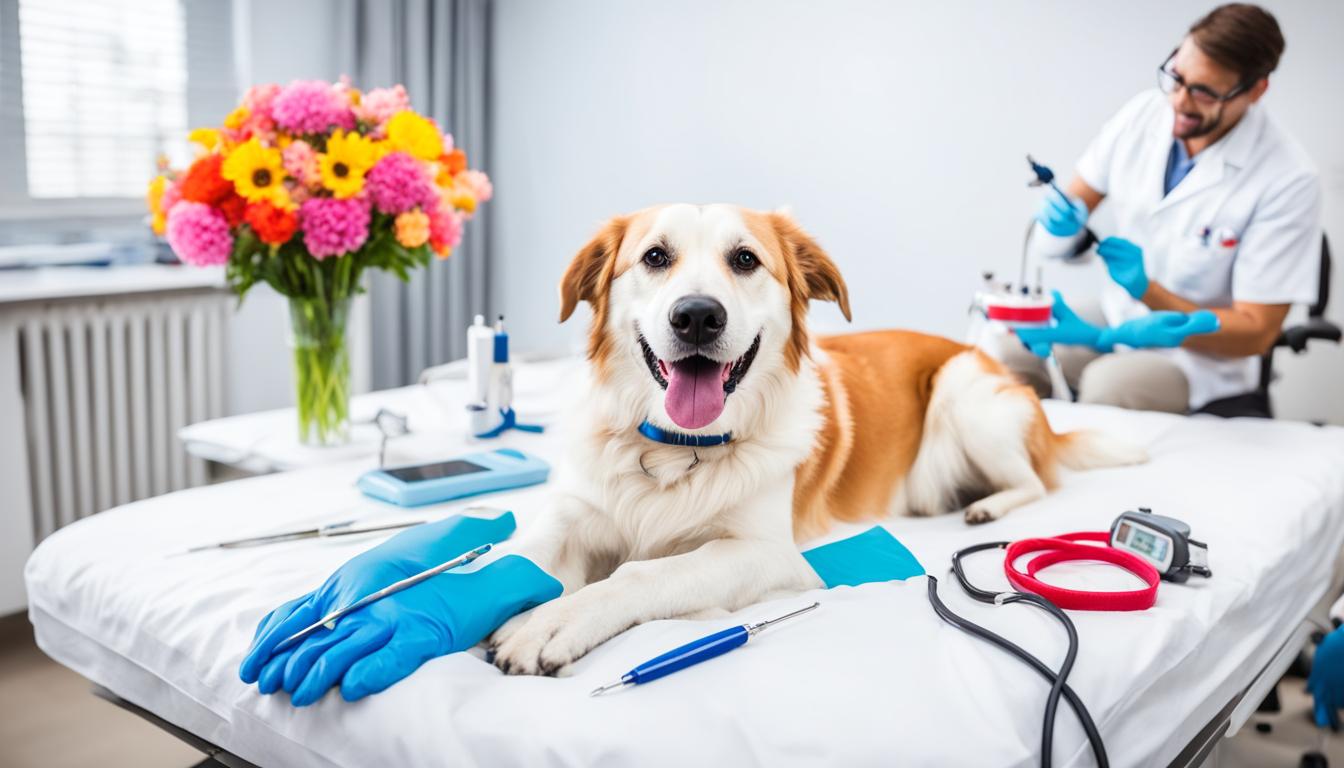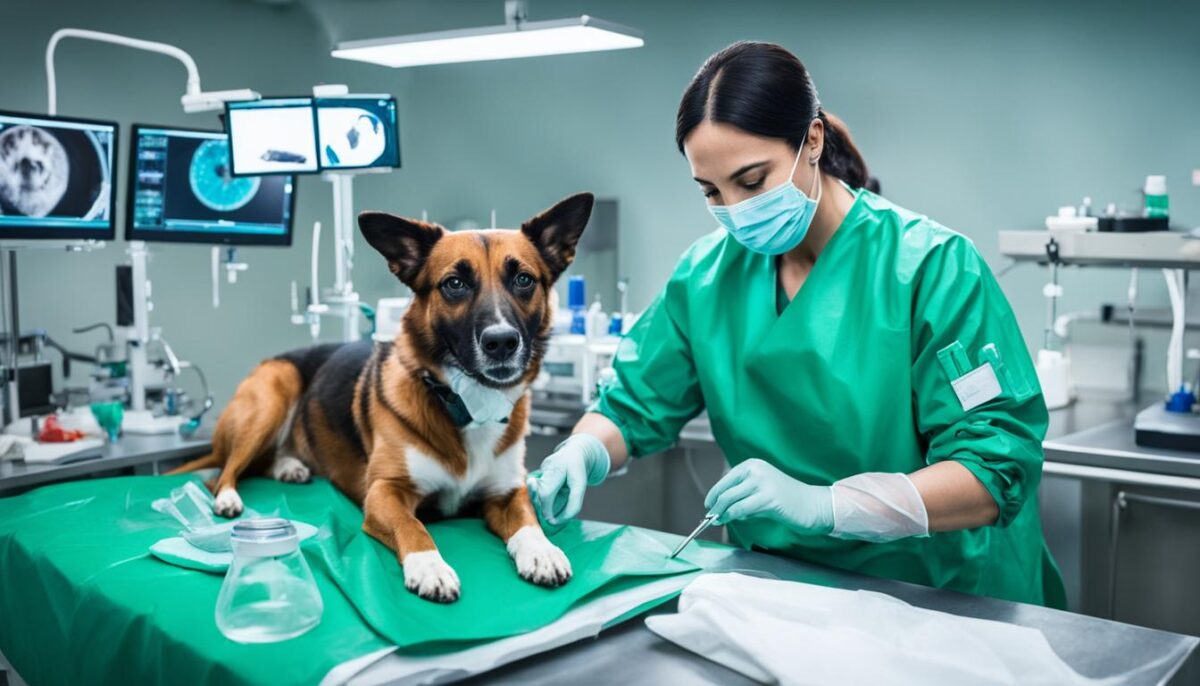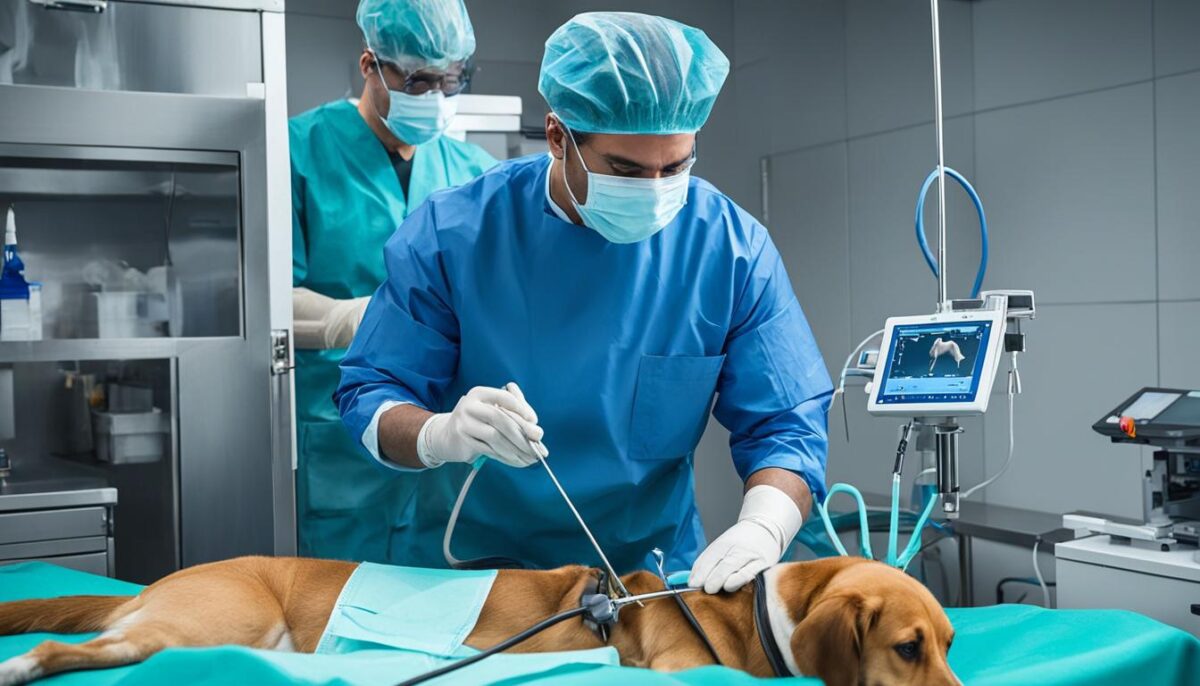If your furry friend is a female dog, you might be thinking about getting her spayed. It’s a common surgery that a lot of dog owners choose. But what if your dog is in heat? You could wonder if it’s still okay to spay her. Well, the good news is that it can be safe when the person doing the surgery knows their stuff. Expert Sara A. Colopy, from the University of Wisconsin School of Veterinary Medicine, says she does it quite a bit and even teaches others to do the same. It might take a little longer and need extra care to avoid too much bleeding, but your pup can be just fine if your vet is careful.
Right after the surgery, don’t be surprised if your dog still acts like she’s in heat. You’ll need to keep her away from male dogs for a couple of weeks to make sure she stays safe. So, let’s dive into what you need to know about spaying female dogs during canine estrus and what dog in heat surgery risks look like.
Key Takeaways
- Spaying your dog while she’s in heat is generally safe with a skilled vet.
- The surgery may need extra time and care due to increased bleeding.
- Even after spaying, a dog may act like she’s still in heat for a short while.
- Keeping your dog away from male dogs post-surgery is crucial for her recovery.
- Discussing the procedure with a vet you trust will help you make the best decision for your pet.
Understanding the Risks of Spaying During Heat
When our furry friends are in heat, vets have to be super careful. If you know about how doctors work hard to keep people safe during surgery, it’s like that for dogs too! Sometimes, it can be a bit tougher when a girl dog is in heat because her body is ready to have puppies. More blood goes to the parts inside her that would hold the puppies. This is called uterine vascularity, and it’s normal but can be a bit tricky for surgery.
Let’s look into what makes this time different for surgery. It’s important to understand so we can keep our dog friends happy and healthy.
The Impact of Increased Blood Flow
Increased blood flow means that there might be more bleeding during surgery. It’s a lot like when you get a cut and it bleeds; the same can happen for dogs when they have surgery. Vets have to watch for this and be ready!
Complications Related to Tissue Friability
Another thing vets watch out for is something called tissue friability. This big word means that some tissues in the dog’s body might break apart more easily. Vets need to be gentle so they don’t harm these tissues.
Potential for Hemorrhage During Surgery
During surgery, vets must make sure the dog doesn’t lose too much blood. This can happen if they’re not careful with the blood vessels that are bigger and full of more blood than usual. This is called canine surgery complications, but good vets know how to handle it!
If things go as planned and the vet takes good care, the surgery can be safe for your dog, just like a regular spay surgery when she’s not in heat. This is all part of the veterinary concerns that your vet takes care of to keep dogs like yours safe!
| Term | What It Means | Why It’s Important |
|---|---|---|
| Increased Blood Flow | Lots of blood going to the uterus. | Knowing this helps vets be ready for more bleeding during surgery. |
| Tissue Friability | Tissues that might break apart easily. | Vets have to be extra gentle to not hurt these tissues. |
| Canine Surgery Complications | Problems that can happen during surgery. | Helps us understand what vets look out for to keep dogs safe. |
| Blood Clotting in Dogs | How blood gets thick to stop bleeding. | Good for vets to know when they need to stop extra bleeding. |
Remember, when girl dogs are in heat, it means their bodies are extra ready to make puppies. This can make things a bit different for surgery, but vets train a lot to learn how to keep dogs safe through it all!
Can Dogs Get Spayed While In Heat?
Have you ever wondered if your dog can have an in-heat spay procedure when she is in her estrus cycle? You might think it’s not possible, but it actually is. It’s common for vets to choose a time after your dog’s heat has ended for this elective canine surgery. This wait is because there’s usually less blood and it’s safer.
That said, sometimes the timing isn’t perfect. If your pup could meet a boy dog and puppies might happen, your vet may suggest it’s best to do the surgery while she’s in heat. This helps stop any unexpected little ones from arriving. But remember, you’ll need to keep her inside and away from male dogs right after the surgery.
Keep in mind, spaying while in heat might make the surgery take more time and cost a bit more. Your dog could act a little different afterward too, like she might think she’s going to have puppies when she’s not. So, you have to be extra careful and watch her close.
Choosing the right time for this surgery can be tricky, but don’t worry. Your vet is there to help you make the best choice for you and your dog! They’ll know all about the surgery timing and what’s safe.
Advancements in Veterinary Techniques and Acceptance
Did you know that your pet’s doctor is getting better and better at helping animals? Yes, it’s true! Nowadays, there are so many new tools and smart ways to keep our furry friends safe when they need surgery. Let’s find out how those smart vets do their amazing work!
The Evolution of Surgical Methods
Once upon a time, fixing a pet who was in heat was pretty hard. But not anymore! Veterinary surgical advancements have brought magical tools like cautery. Cautery is like a super-hot pen that stops bleeding—zip, zap, no more ouch! Plus, with everyone sharing tips on the internet, vets everywhere are learning to be like superheroes to our pets!
Growing Confidence Among Veterinarians
Because of all the new things to help in surgery, vets are feeling super confident. They are like, ‘Yes, I can do this!’ and, ‘I’m ready to help this pet!’ Even when things get difficult, they are not scared. They know they have cool gadgets and friends to help them do a great job.
The Role of Technology and Mentorship
It’s not just about having fancy gadgets. It’s also about helping each other. Veterinary mentorship means that smart, experienced vets teach the new vets how to be amazing. Everyone works together to make sure our animal friends get the best care. Whether it’s through a tiny camera during surgery or a kind word of advice, technology and friends make all the difference in animal care.
Remember, every time you take your pet to the vet, there’s a lot of love and clever work that goes into keeping them healthy. Thanks to all the vets for being so cool!
What Owners Should Know Before Deciding
Before you decide to spay your dog when she’s in heat, there are some key things to think about. First off, if she has surgery during this time, male dogs may still be very interested in her, and that’s not good. Plus, she might act as if she’s going to have puppies even when she’s not. Spay procedure preparation includes considering these behaviors and how you’ll manage them.
Post-Surgery Care Requirements
After the spay surgery, it’s your job to take care of your dog. You’ll need to give her a quiet spot to rest and heal, and keep her indoors away from other dogs, especially boys. Knowing dog spay recovery tips is part of responsible pet ownership. Your vet will give you advice on how to make sure your furry friend gets back to her playful self quickly and safely.
Considerations for Timing the Procedure
Spaying your dog before she has her first heat is often the best way to go. This helps to keep her from getting sick with things like mammary cancer. But if you didn’t do this and she’s already having heats, then wait about three months after her heat to spay her. That’s when it is safer and easier for her. Be sure to ask your vet what they think is the best time. They know your dog and can help decide the perfect day for surgery. Remember, pre-spay considerations are all about making the best choices for your pet’s health.
FAQ
Is it safe to spay my dog while she’s in heat?
Yes, spaying your dog during her heat cycle can be safe if performed by a skilled surgeon. Despite being a more complex surgery due to increased blood flow to the uterus, advancements in veterinary techniques have made it possible. However, it is important to discuss the risks and benefits with your vet.
What are the risks of spaying my dog during her heat cycle?
The main risks include increased bleeding due to heightened uterine vascularity and the potential for tissue friability, which may complicate the surgery and extend the procedure time. It’s crucial to have a veterinarian who is experienced with these conditions for the best outcomes.
How does being in heat affect my dog’s spay surgery?
When a dog is in heat, there is more blood flow to the reproductive organs, and the tissues can be more breakable, which might lead to a longer surgery with more stitches. A proficient veterinarian will adjust their surgical techniques to handle these changes safely.
Are there any advancements in veterinary surgery that help with spaying dogs in heat?
Absolutely, there have been significant advancements in veterinary surgical methods, including the use of cautery tools to reduce bleeding and minimally invasive techniques like laparoscopic surgery. These, along with improved training and mentorship, have enhanced the outcomes of spays during the canine estrus cycle.
Can spaying my dog while she’s in heat lead to different post-surgery behavior?
After the surgery, your dog may still exhibit signs of being in heat for a short period. It’s important to prevent contact with male dogs for two to three weeks post-surgery, as the mating could be harmful to her recovery process.
How can I prepare for my dog’s spaying procedure?
It’s important to discuss the timing of the surgery with your veterinarian and follow their advice on pre- and post-operative care. Ensure your home environment is calm for her recovery, avoid strenous activity, and monitor the surgical site for any signs of infection or complications.
What should I consider when deciding the timing of spaying my dog?
Consider factors like whether your dog has access to male dogs, the risk of unwanted pregnancy, and the advantages of spaying before the first heat cycle. Vets generally recommend waiting until three months after the heat cycle has ended, but each case can be unique, and your vet’s guidance is key.
Why do some veterinarians prefer to spay dogs after their heat cycle?
Vets may prefer to wait because the risks associated with surgery, such as increased bleeding and surgical complications, are minimized when the dog is not in heat. This can also reduce the surgery time and associated costs.
How has social media influenced veterinary surgery practices?
Social media has become a valuable tool for veterinarians to share experiences, techniques, and advice quickly, thereby expanding their knowledge and confidence in performing surgeries, including spaying dogs during their heat cycle.


